2003 PONTIAC GRAND PRIX trailer
[x] Cancel search: trailerPage 252 of 378
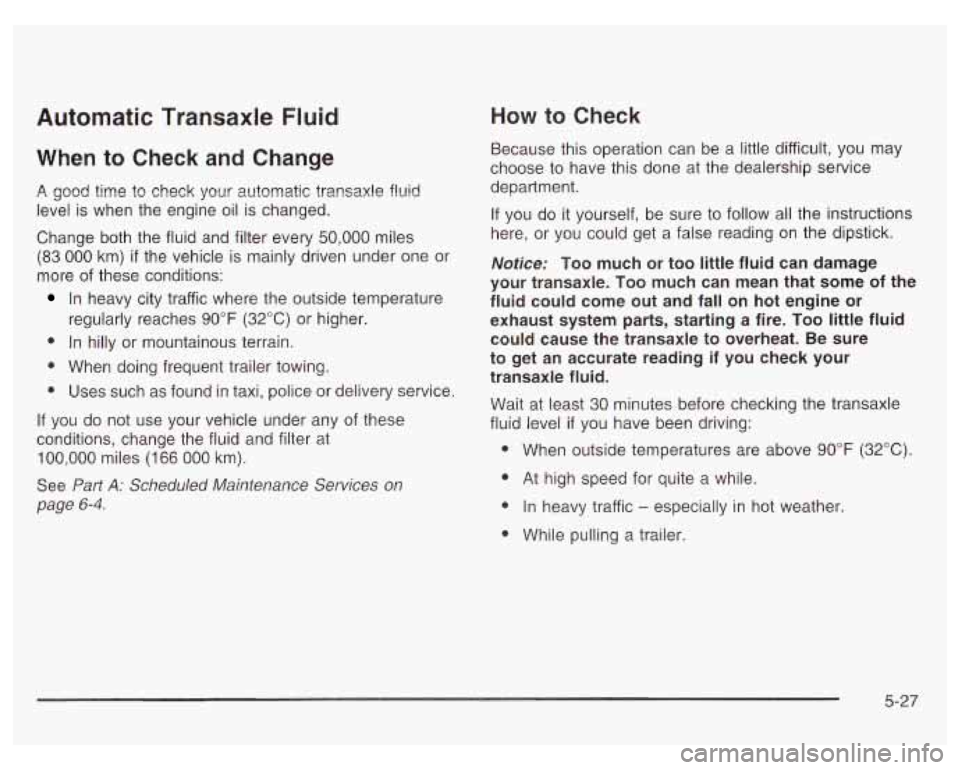
Automatic Transaxle Fluid
When to Check and Change
A good time to check your automatic transaxle fluid
level is when the engine oil is changed.
Change both the fluid and filter every 50,000 miles
(83
000 km) if the vehicle is mainly driven under one or
more of these conditions:
In heavy city traffic where the outside temperature
0 In hilly or mountainous terrain.
0 When doing frequent trailer towing.
0 Uses such as found in taxi, police or delivery service.
regularly reaches
90°F (32°C)
or higher.
If you do not use your vehicle under any of these
conditions, change the fluid and filter at
100,000 miles (166 000 km).
See Part
A: Scheduled Maintenance Services on
page
6-4.
How to Cheek
Because this operation can be a little difficult, you may
choose to have this done at the dealership service
department.
If you do it yourself, be sure to follow all the instructions
here, or you could get a false reading on the dipstick.
Nofice: Too much or too little fluid can damage
your transaxle.
Too much can mean that some of the
fluid could come out and fall on hot engine or
exhaust system parts, starting a fire.
Too little fluid
could cause the transaxle to overheat. Be sure
to get an accurate reading
if you check your
transaxle fluid.
Wait at least 30 minutes before checking the transaxle
fluid level
if you have been driving:
When outside temperatures are above
90°F (32°C).
At high speed for quite a while.
In heavy traffic
- especially in hot weather.
While pulling a trailer.
5-27
Page 258 of 378
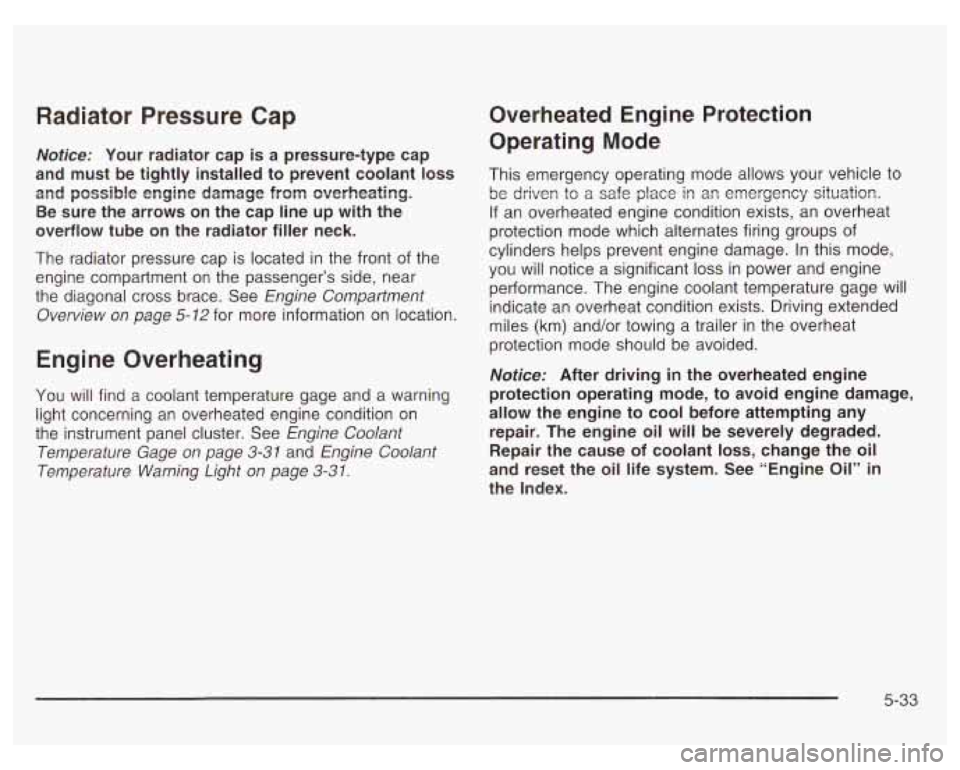
Radiator Pressure Cap
Notice: Your radiator cap is a pressure-type cap
and must be tightly installed to prevent coolant
loss
and possible engine damage from overheating.
Be sure the arrows on the cap line up with the
overflow tube
on the radiator filler neck.
The radiator pressure cap is located in the front of the
engine compartment on the passenger’s side, near
the diagonal cross brace. See Engine Compartment
Overview on page
5-12 for more information on location.
Engine Overheating
You will find a coolant temperature gage and a warning
light concerning an overheated engine condition on
the instrument panel cluster. See Engine Coolant
Temperature Gage
on page 3-31 and Engine Coolant
Temperature Warning Light
on page 3-31.
Overheated Engine Protection
Operating Mode
This emergency operating mode allows your vehicle to
be driven tu
a safe place in an emergency situation.
If an overheated engine condition exists, an overheat
protection mode which alternates firing groups of
cylinders helps prevent engine damage. In this mode,
you will notice a significant
loss in power and engine
performance. The engine coolant temperature gage will
indicate an overheat condition exists. Driving extended
miles (km) and/or towing a trailer in the overheat
protection mode should be avoided.
Nofice: After driving in the overheated engine
protection operating mode, to avoid engine damage,
allow the engine to cool before attempting any
repair. The engine oil will be severely degraded.
Repair the cause of coolant
loss, change the oil
and reset the oil life system. See “Engine Oil”
ir
the Index.
5-33
Page 260 of 378
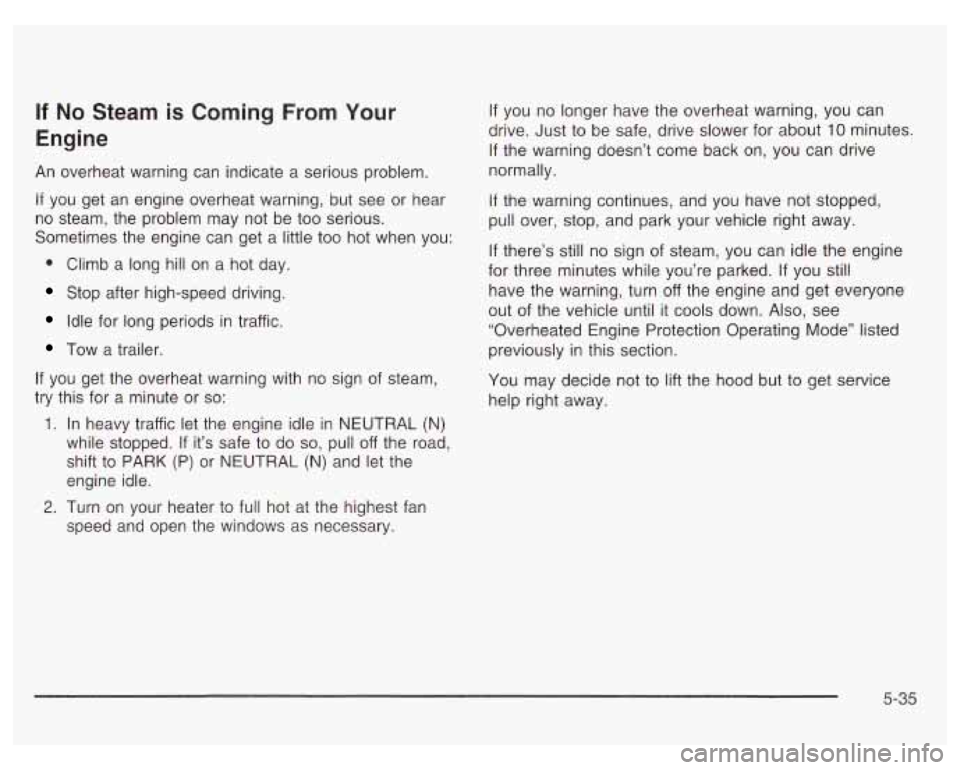
If No Steam is Coming From Your
Engine
An overheat warning can indicate a serious problem.
If you get an engine overheat warning, but see or hear
no steam, the problem may not be too serious.
Sometimes the engine can get a little too hot when you:
Climb a long hill on
a hot day.
Stop after high-speed driving.
Idle for long periods in traffic.
Tow a trailer.
If you get the overheat warning with no sign
of steam,
try this for a minute or
so:
1. In heavy traffic let the engine idle in NEUTRAL (N)
while stopped.
If it’s safe to do so, pull off the rozd,
shift to PARK
(P) or NEUTRAL (N) and let the
engine idle.
If you no longer have the overheat warning, you can
drive. Just to be safe, drive slower for about
10 minutes.
If the warning doesn’t come back on, you can drive
normally.
If the warning continues, and you have not stopped,
pull over, stop, and park your vehicle right away.
If there’s still no sign of steam, you can idle the engine
for three minutes while you’re parked. If you still
have the warning, turn off the engine and get everyone
out of the vehicle until it cools down. Also, see
“Overheated Engine Protection Operating Mode” listed
previously in this section.
You may decide not to lift the hood but to get service
help right away.
2. Turn on your heater to full hot at the highest fan
speed and open the windows as necessary.
5-35
Page 336 of 378
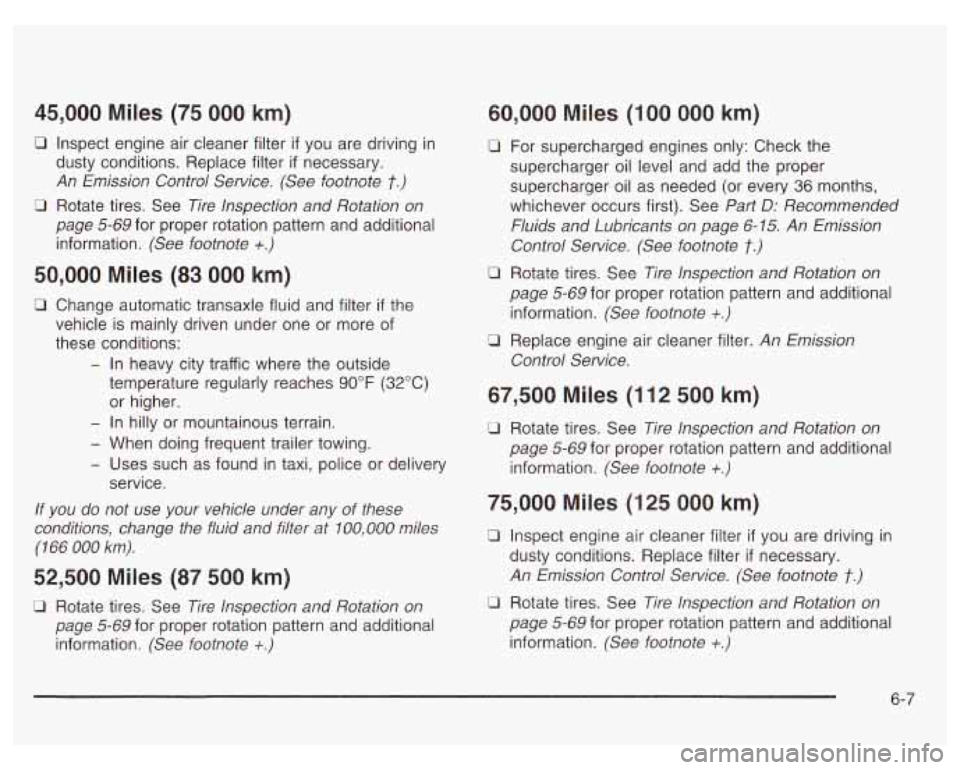
45,000 Miles (75 000 km)
0 Inspect engine air cleaner filter if you are driving in
dusty conditions. Replace filter
if necessary.
An Emission Control Service. (See footnote
t.)
0 Rotate tires. See Tire Inspection and Rotation on
page 5-69 for proper rotation pattern and additional
information. (See footnote
+.)
50,000 Miles (83 000 km)
0 Change automatic transaxle fluid and filter if the
vehicle is mainly driven under one or more of
these conditions:
- In heavy city traffic where the outside
temperature regularly reaches
90°F (32°C)
or higher.
- In hilly or mountainous terrain.
- When doing frequent trailer towing.
- Uses such as found in taxi, police or delivery
service.
If you do not use your vehicle under any of these
conditions, change the fluid and filter at
100,000 miles
(166
000 km).
52,500 Miles (87 500 km)
0 Rotate tires. See Tire Inspection and Rotation on
page 5-69 for proper rotation pattern and additional
information. (See footnote
+-)
60,000 Miles (100 000 km)
0 For supercharged engines only: Check the
supercharger
oil level and add the proper
supercharger oil as needed (or every
36 months,
whichever occurs first). See Part
D: Recommended
Fluids and Lubricants on page 6- 15. An Emission
Control Service. (See footnote
t.)
0 Rotate tires. See Tire Inspection and Rotation on
page 5-69 for proper rotation pattern and additional
information. (See footnote
+.)
Control Service.
0 Replace engine air cleaner filter. An Emission
67,500 Miles (112 500 km)
U Rotate tires. See Tire Inspection and Rotation on
page 5-69 for proper rotation pattern and additional
information. (See footnote
+.)
75,000 Miles (125 000 km)
0 Inspect engine air cleaner filter if you are driving in
dusty conditions. Replace filter
if necessary.
An Emission Control Service. (See footnote
t.)
0 Rotate tires. See Tire Inspection and Rotation on
page 5-69 for proper rotation pattern and additional
information. (See footnote
+.)
6-7
Page 337 of 378

82,500 Miles (137 500 km)
0 Rotate tires. See Tire Inspection and Rotation on
page
5-69 for proper rotation pattern and additional
information. (See footnote
+.)
90,000 Miles (150 000 km)
0 Replace engine air cleaner filter. An Emission
Control Service.
0 For supercharged engines only: Check the
supercharger oil level and add the proper
supercharger oil as needed (or every 36 months,
whichever occurs first). See Part D: Recommended
Fluids and Lubricants on page
6-15. An Emission
Control Service. (See footnote
f.)
Ll Rotate tires. See Tire Inspection and Rotation on
page 5-69 for proper rotation pattern and additional
information. (See footnote
+.)
97,500 Miles (162 500 km)
U Rotate tires. See Tire Inspection and Rotation on
page 5-69 for proper rotation pattern and additional
information. (See footnote
+.)
100,000 Miles (1 66 000 km)
0 Inspect spark plug wires. An Emission Control
0 Replace spark plugs. An Emission Control Service.
Service.
CI Change
automatic transaxle fluid and filter if the
vehicle is mainly driven under one or more
of
these conditions:
- In heavy city traffic where the outside
temperature regularly reaches
90°F (32°C)
or higher.
- In hilly or mountainous terrain.
- When doing frequent trailer towing.
- Uses such as found in taxi, police or delivery
service.
0 If you haven’t used your vehicle under severe service
conditions listed previously and, therefore, haven’t
changed your automatic transaxle fluid, change both
the fluid and filter.
150,000 Miles (240 000 km)
0 Drain, flush and refill cooling system (or every
60 months since last service, whichever occurs first).
See Engine Coolant on page
5-30 for what to use.
Inspect hoses. Clean radiator, condenser, pressure
cap and neck. Pressure test the cooling system
and pressure cap. An Emission Control Service.
0 Inspect engine accessory drive belt. An Emission
Control Service.
6-8
Page 363 of 378
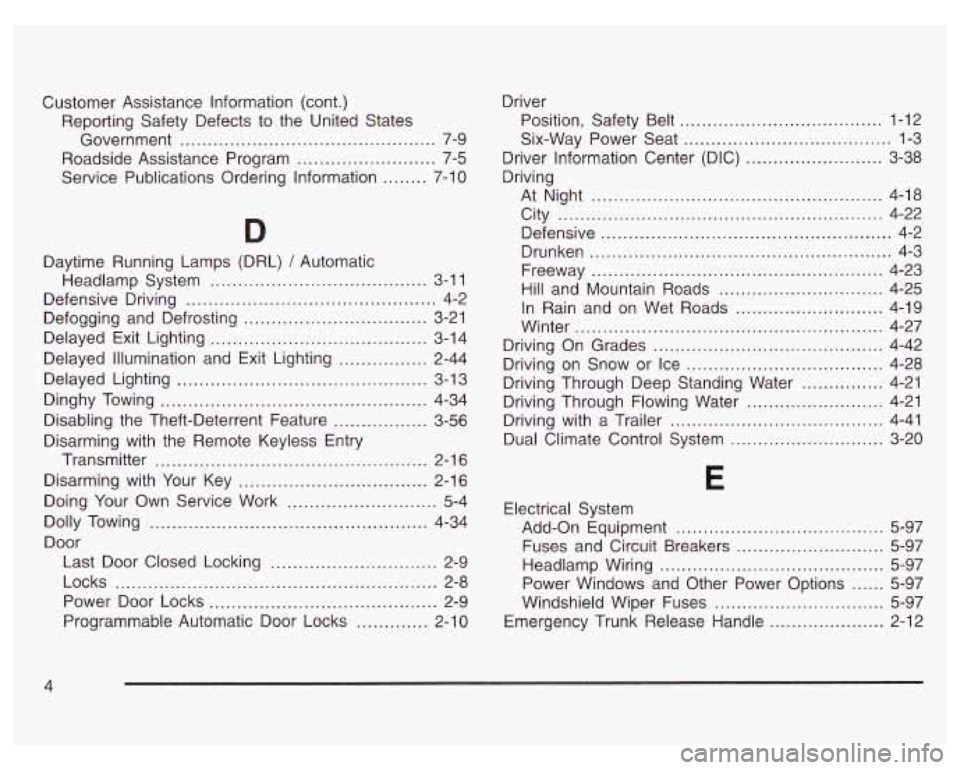
Customer Assistance Information (cont.)
Reporting Safety Defects to the United States
Government
.............................................. 7-9
Roadside Assistance Program
......................... 7-5
Service Publications Ordering Information
........ 7-1 0
D
Daytime Running Lamps (DRL) / Automatic
Headlamp System
....................................... 3-1 1
Defensive Driving ............................................. 4-2
Defogging and Defrosting
................................. 3-21
Delayed Exit Lighting
....................................... 3-14
Delayed Illumination and Exit Lighting
................ 2-44
Delayed Lighting
............................................. 3-1 3
Dinghy Towing
................................................ 4-34
Disabling the Theft-Deterrent Feature
................. 3-56
Disarming with the Remote Keyless Entry
Transmitter
................................................. 2-1 6
Disarming with Your Key
.................................. 2-16
Doing Your Own Service Work
........................... 5-4
Dolly Towing
.................................................. 4-34
Door Last Door Closed Locking
.............................. 2-9
Power Door Locks
......................................... 2-9
Programmable Automatic Door Locks
............. 2-1 0
Locks .......................................................... 2-8 Driver
Position. Safety Belt
..................................... 1-12
Six-Way Power Seat
...................................... 1-3
Driver Information Center (DIC)
......................... 3-38
Driving At Night
..................................................... 4-18
City
........................................................... 4-22
Defensive
..................................................... 4-2
Drunken
....................................................... 4-3
Freeway
..................................................... 4-23
Hill and Mountain Roads
.............................. 4-25
In Rain and on Wet Roads
........................... 4-19
Winter
........................................................ 4-27
Driving On Grades
.......................................... 4-42
Driving on Snow or Ice
.................................... 4-28
Driving Through Deep Standing Water
............... 4-21
Driving Through Flowing Water
......................... 4-21
Dual Climate Control System
............................ 3-20
Driving with
a Trailer
....................................... 4-41
Electrical System
Add-on Equipment
.......... ................. 5-97
Fuses and Circuit Breakers
................... 5-97
Headlamp Wiring
......................................... 5-97
Power Windows and Other Power Options
...... 5-97
Windshield Wiper Fuses
............................... 5-97
Emergency Trunk Release Handle
................. 2-12
4
Page 364 of 378
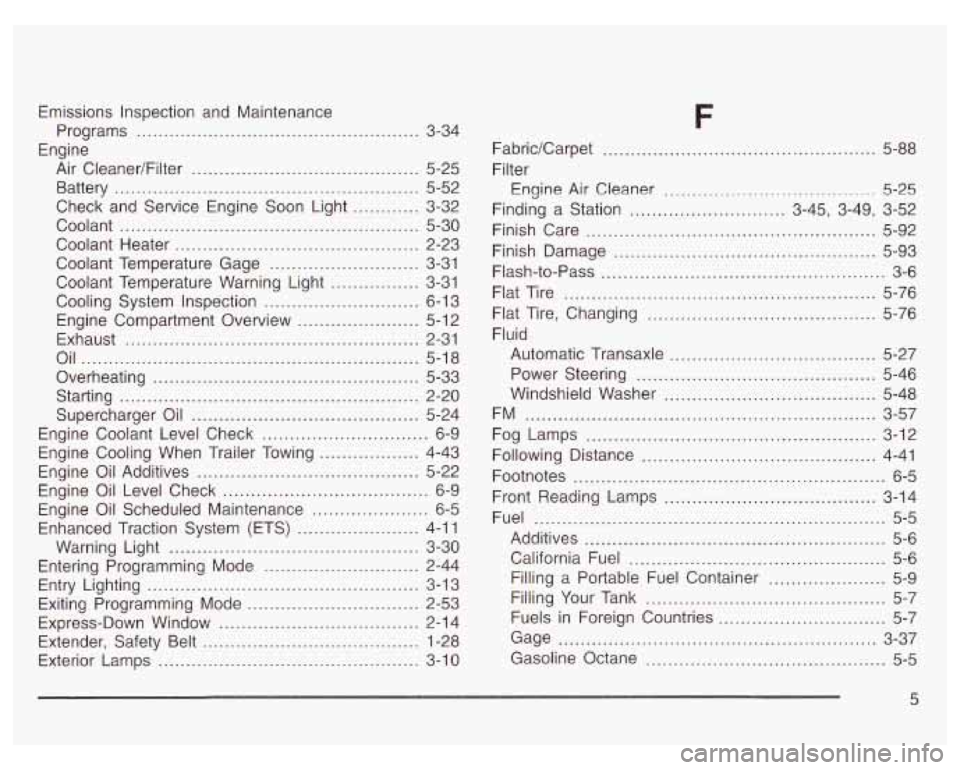
Emissions Inspection and Maintenance
Engine Programs
................................................... 3-34
Air Cleaner/Filter
......................................... 5-25
Battery
....................................................... 5-52
Check and Service Engine Soon Light ............ 3-32
Coolant
...................................................... 5-30
Coolant Heater
............................................ 2-23
Coolant Temperature Gage
........................... 3-31
Coolant Temperature Warning Light
................ 3-31
Cooling System Inspection
............................ 6-1 3
Engine Compartment Overview
...................... 5-1 2
Exhaust ..................................................... 2-31
Oil
............................................................. 5-18
Starting
...................................................... 2-20
Supercharger Oil
......................................... 5-24
Engine Coolant Level Check
.............................. 6-9
Engine Cooling When Trailer Towing
.................. 4-43
Engine Oil Additives
........................................ 5-22
Engine Oil Level Check
..................................... 6-9
Engine Oil Scheduled Maintenance
..................... 6-5
Warning Light
............................................. 3-30
Entering Programming Mode
......................... 2-44
Entry Lighting
........................ ...... 3-13
Exiting Programming Mode
.......... ...... 2-53
Extender, Safety Belt
.. ...................... 1-28
Exterior Lamps
............................................... 3-1 0
Overheating ................................................ 5-33
Enhanced Traction System (ETS)
...................... 4-1 1
Express-Down Window
................................. 2-1 4
F
, ........... FabridCarpet ........... ........... 5-88
Filter
Engine Air Cleaner ............................... :~~=:=~ 5-25
Finding a Station ............................ 3-45, 3-49, 3-52
Finish Care
.................................................... 5-92
Finish Damage
............................................... 5-93
Flash-to-Pass
................................................... 3-6
Flat Tire
........................................................ 5-76
Flat Tire, Changing
......................................... 5-76
Fluid Automatic Transaxle
..................................... 5-27
Power Steering
........................................... 5-46
Windshield Washer
...................................... 5-48
Fog Lamps
................................. , ........... 3-12
Following Distance
.......................................... 4-41
Footnotes
........................................................ 6-5
Front Reading Lamps
...................................... 3-14
Fuel
............................................................... 5-5
Additives ...................................................... 5-6
California Fuel
.............................................. 5-6
Filling a Portable Fuel Container
..................... 5-9
Filling Your Tank
........................................... 5-7
Fuels in Foreign Countries
.............................. 5-7
Gage
......................................................... 3-37
Gasoline Octane
........................................ 5-5
FM ............................................................... 3-57
5
Page 366 of 378
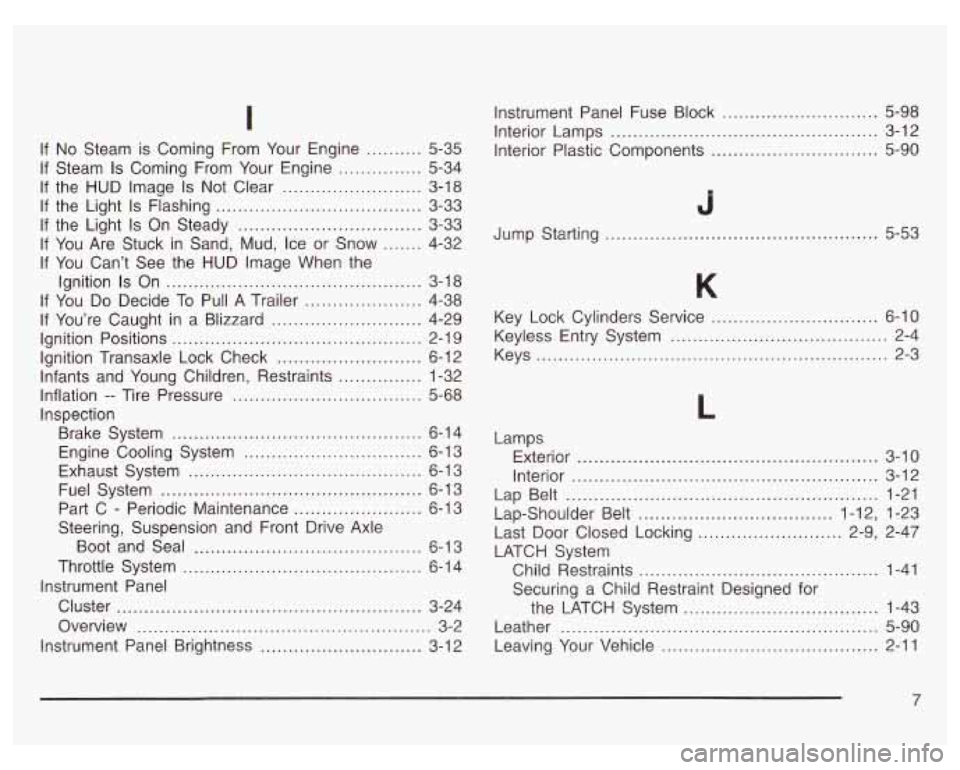
If No Steam is Coming From Your Engine .......... 5-35
If Steam
Is Coming From Your Engine ............... 5-34
If the HUD Image
Is Not Clear ......................... 3-18
If the Light
Is Flashing ..................................... 3-33
If the Light
Is On Steady ................................. 3-33
If You Are Stuck in Sand, Mud, Ice or Snow
....... 4-32
If You Can’t See the HUD Image When the
Ignition
Is On .............................................. 3-18
If You
Do Decide To Pull A Trailer ..................... 4-38
Ignition Positions
............................................. 2-1 9
Ignition Transaxle Lock Check
.......................... 6-12
Infants and Young Children, Restraints
............... 1-32
Inflation
-- Tire Pressure ............................... 5-68
Inspection Brake System
........................... ........... 6-14
Engine Cooling System
................................ 6-13
Exhaust System
.......................................... 6-13
Fuel System
............................................... 6-13
Part C
- Periodic Maintenance ....................... 6-13
Steering, Suspension and Front Drive Axle
Boot and Seal
......................................... 6-1 3
Throttle System
........................................... 6-14
Cluster
....................................................... 3-24
Overview
..................................................... 3-2
Instrument Panel Brightness
............................. 3-1 2
If
You’re Caught in a Blizzard
........................... 4-29
Instrument Panel Instrument Panel
Fuse Block
........................ 5-98
Interior Plastic Components .............................. 5-90
Interior
Lamps
................................................ 3-12
Jump Starting
................................................. 5-53
Key Lock Cylinders Service .............................. 6-10
Keyless Entry System
....................................... 2-4
Keys
............................................................... 2-3
L
Lamps Exterior
............................................... 3-10
Interior
....................................................... 3-12
Lap Belt
........................................................ 1-21
Lap-Shoulder Belt
................................... 1.12. 1-23
Last Door Closed Locking
.......................... 2.9. 2-47
LATCH System Child Restraints
........................................... 1-41
Securing a Child Restraint Designed for
the LATCH System
................................... 1-43
Leather
......................................................... 5-90
Leaving Your Vehicle
....................................... 2-11
7